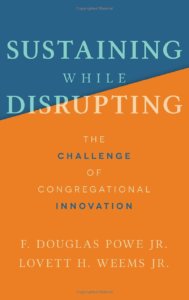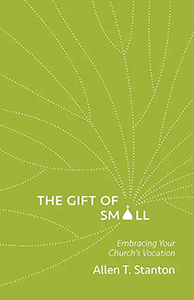
Do you lead a small church? In this episode Allen Stanton shares how small congregations can be surprisingly nimble in the face of change and effective in spiritual formation because of their inherently relational nature.
Listen on Apple Podcasts | YouTube Music | Spotify
Watch on YouTube

- Transcript—Click or Tap to Read
-
Announcer: Leading Ideas Talks is brought to you by the Lewis Center for Leadership of Wesley Theological Seminary in Washington, DC. Subscribe free to our weekly e-newsletter, Leading Ideas, at churchleadership.com/leadingideas.
Leading Ideas Talks is also brought you by the book Sustaining While Disrupting: The Challenge of Congregational Innovation. Authors Douglas Powe and Lovett Weems offer church leaders insights on practical skills for two crucial tasks: First, to sustain and strengthen foundational elements of the churches they serve, and second, to guide the critical innovation required to address a context vastly different from the one that current assumptions and behaviors fit. Learn more and order now at churchleadership.com/books.
Do you lead a small church? In this episode Allen Stanton shares how small congregations can be surprisingly nimble in the face of change and effective in spiritual formation because of their inherently relational nature.
Ann Michel: Welcome to Leading Ideas Talks. I’m Ann Michel, I’m a senior consultant with the Lewis Center for Church Leadership of Wesley Theological Seminary. I’m also one of the editors of Leading Ideas e-newsletter. And I’m pleased to be your host for this episode of Leading Ideas Talks. My guest today is Allen Stanton, who’s an ordained elder in the United Methodist Church, currently serving as a consulting fellow with the University of the Ozarks’ Thriving in Rural Ministry Initiative. In 2021, Allen wrote Reclaiming Rural: Building Thriving Rural Congregations. And I had the opportunity to talk with him about that book a few years ago. Today we’re going to be talking about his new book, which is The Gift of Small: Embracing Your Church’s Vocation. Welcome, Allen. I think you’re one of the few people we’ve had as a guest on Leading Ideas Talks, not once, but twice. So welcome back!
Allen Stanton: Thanks for having me.
Ann Michel: Let me begin by asking you, why are you so interested, dare I say passionate, about smaller congregations?
Allen Stanton: Oh, that’s a great question. I think so much of my own spiritual journey has been in small congregations and so that’s a big part of it: my own spiritual formation. My own understanding of vocation has happened in small churches. And while I’m, you know, in what we Methodists call “extension ministry,” I attend a small membership church, and I see how that’s impacting my family. So, I really care a lot about small churches just as a person who’s been formed in them. I also think as our society shifts, as religion and the way that people engage with religion changes, small churches are going to become really the norm for how people engage. They’re already the largest number of churches out there. And we sometimes have an idea that that means they’re failing or that they’re bad. And I think they’re doing good stuff. And I, so part of this is really, I just want to lift up all the good things that small churches are already doing for the kingdom of God. And so that is a large part of the passion, just to amplify what they’re doing.
Ann Michel: That actually leads to the second question I wanted to ask, which is, why do you think that the contributions of smaller churches are so often overlooked?
Allen Stanton: Yeah so, I talk about this a little bit in the book. One of the things is that I think our theological imagination—I don’t want to say like malformed, but it can be a little bit misguided, is a better word. So, we often think about success in terms of growth, and we think about the Kingdom of God. We have a mandate from Jesus, right? It’s the Great Commission to baptize and make believer, right? Like we are supposed to make disciples. And so, people have said that what we should be doing is making disciples in our local congregations.
And that kind of ties into how we think about success in all sorts of areas. So, my day job, I work at—I was a consulting fellow. I am a consulting fellow for the University Ozarks. But my day job is at a health science center. And so, we think all the time about patient volume, and we think about things like expanding access to care and how do we get more and more.
As a regular person, I worry about things like my paycheck, right? I want more money. I don’t think I’m supposed to say that, but like we all kind of care about those things. And I think that has sort of seeped into our understanding of the church. Where, when we start talking about what it means to be a successful church, we often just sort of lapse into that conversation to say “Bigger is better.”
And we see that in all sorts of ways. Where you know, you go to an annual conference gathering or the like, and the churches that we highlight as doing meaningful ministry, it’s often based on the number of programs that they’re doing or the amount of money they’re able to spend on programs. And so, I really think it’s just that sort of imagination. We’ve said that bigger is better and that growth is good. And, if you’re not growing, you’re dying, to borrow from Jim Collins. And so, the small church has gotten overlooked in that.
Ann Michel: So, in your book, you talk a lot about the inherent relationality of small churches, and you talk about how leadership in small congregations needs to be relational leadership. So, I wondered if you could explain a little bit about what your understanding of relational leadership within a small church context is. What does it look like?
Allen Stanton: It looks like a lot of different things. That’s a really great question. I remember when I was starting out as a pastor, I had a layperson who did so much stuff in our small membership congregation. I mean like, they were running the youth group. They were folding bulletins. They were printing the bulletins. They were in charge of worship, right? They were cleaning the church. Like everything that really happened in the church, they were in charge of. And we had a debate one day about something in the worship service. And I wanted it to be still … I wanted the worship service to be an hour long. And she was saying, “Oh no. We can go on and people aren’t going to care.” And it was kind of a tense conversation. And I remember reaching out to a mentor of mine. And he said, “Well, what else is happening in her life?” Well, her father had just died, right? And the church was this place where she had some stability and some control in a time when like everything in her life was spiraling out of control. And I think the small church is really one of the few places you can come and bring your whole self, and you can be that. So, relational leadership a lot of times is just remembering that you’re in a place where you’re talking to another human being and you’re bringing all these things into bear.
I also think, organizationally, there are a lot of studies around this, people engage in small organizations differently than they engage in large organizations. So, you can look at a large organization, a large nonprofit. Volunteers are going to go for particular programs and they’re going to help out with those particular programs. And they’re not really going to come back around until the next particular program. So, this weekend in Memphis, we have the St Jude’s Marathon, right? They’re going to have tons of volunteers that go, and they do that, and then they go away. In smaller organizations people show up because that’s their community. They are part of making sure that organization stays afloat, that those nonprofits stay afloat, and they have a really vested interest in what happens in that organization. But it really is their community. And they go because it is their community. It’s where they can be themselves and make friends and have deep relationships. And the small church, I think, has to sort of recognize that when we are leading, we’re not leading a hierarchy. We are leading all these people who are comprised of these relational networks.
Ann Michel: Right, yeah. So, I think, in the book, you talk about it being flatter, not necessarily being a hierarchical organization system like we think of in organizations. And that was really helpful to me. I wanted to ask, what do you think are some of the common mistakes or pitfalls that incoming clergy make when they enter into the life of a smaller congregation?
Allen Stanton: I think the big one is the one you just mentioned, right? They’re not hierarchical organizations. And so, I think sometimes people come into a small church and they sort of assume it’s like a little version of a big organization or a big church, right? That you have the pastor who is going to make a decision and then somebody is going to carry out the pastor’s directive, and a staff, right? And that’s not going to happen in a small membership church, largely because you’re not going to have a staff.
I think that people assume that small churches can’t change. Small churches can change and they do change pretty rapidly. They’re quite nimble I think, in fact. But you have to understand the history of what you’re trying to change and how you’re trying to change it. And again, those decisions are going to be made relationally. A good example is, if you are down a lay leader, or a lay reader, or a liturgist for a Sunday, chances are in a small church, you can just find someone else to fill in for that at the last minute. Because people are committed to the organization and churches make these pivots all the time. I think in my church, we don’t ever have a sure schedule, right? Whoever’s going to pass the offering plates is just going to get “voluntold” about five minutes before the service. It’s just how it happens; you know? So, we’re quite nimble. And that’s one of the things, I think, a lot of people when they step into the small church haven’t figured out how to capitalize on. So, I would say those two—understanding that you’re really not a sort of hierarchical organization and also that you can be quite nimble.
Sustaining While Disrupting: The Challenge of Congregational Innovation
Authors Douglas Powe and Lovett Weems offer church leaders insights on practical skills for two crucial tasks: First, to sustain and strengthen foundational elements of the churches they serve, and second, to guide the critical innovation required to address a context vastly different from the one that current assumptions and behaviors fit. Learn more and order now at churchleadership.com/books.
Ann Michel: Yeah, I really appreciate the point you make about that because I think there’s a stereotype of smaller congregations as being really change averse and sort of stuck in their ways. But you make the point repeatedly that small churches are capable of changing in part because they are so flat, and decisions can be made in a more organic way.
Allen Stanton: Yeah. It has to be done in a smart way, though. I think I use the story in the book of someone wanting to replace, like, a communion table—or, not a communion table, but a baptismal font, right? And if I’m a pastor, and I go in trying to get an early win and say, “Look, the baptismal font is decaying and it’s ugly and it’s leaking.” I’m sitting as a pastor going like, “Oh, I can toss it out and everyone will be fine.” I think where people say churches are resistant to change it is because somebody might hear that in the church and say, “I don’t want to do that.” But really what’s happening is that people are looking at this and saying, “My grandmother was baptized here. My mother was baptized in that font. My daughter was baptized in that font. I was baptized in that font. You’re not going to throw away four or five generations of history, and history of our faith, and a sign of our faithfulness.” But if you do that in a relational way and say, “We do need to change this. How do we preserve that memory?” You’d be really surprised with what happens. I’ve seen a church in the mountains of North Carolina that had a very similar situation. And this person, he was a woodworker, just made this beautiful, handmade baptismal font for his church because he kind of recognized the need, right? And so, that was not a difficult decision to arrive at. It just had to be done understanding sort of the emotional capacity of the congregation.
Ann Michel: Yeah. I think you do a really good job in the book about, sort of, describing some of the decision-making dynamics that need to be attended to in a smaller church context. So another one of the stereotypes about small churches that you take on is the assumption that all small churches are aging churches, or all small churches are dying churches. What do you see going on in terms of the age dynamics in smaller churches and what does it mean for their approach to ministry?
Allen Stanton: Yeah. So that’s my least favorite chapter of the book which I think I’m not supposed to say on a podcast. But it was a lot of statistics, right? And trying to figure out, how do you communicate these statistics in a way that people can read them? So first, I think it’s really important to remember that all churches across the board are aging. That is—I mean—except for a handful of really large churches, almost every single size congregation is aging. So, it’s not just small membership churches. Small membership churches are not immune from that decline. And in some places, they might be a little bit average-age-older than in other places. And that’s normal because the population around that community is probably also a little bit older. But on the whole, small membership congregations—there are very few … We kind of have this picture in our head, twofold. One is like they’re full of people on death’s doorstep and that’s not true. They’re actually quite diverse in their age and lifespans. And then the other thing is that even if you do have a church of people who are a plurality, I don’t want to say majority, but a plurality who are above the age of 55 or 60, being 55 or 60 in today’s world is very different than being 55 and 60 in you know, the 1930s, right? If you’re 65—I had lunch with a colleague today who’s 65 and he’s thinking about what retirement looks like. And he’s thinking ten years off, right? You still have a lot of life left at 55 or 60 or 65. And so, those are really active congregations. And the other reality of that is, because there’s more diversity, because people are living longer, you have a lot of opportunity for intergenerational relationships.
So, I have a four-year-old and a seven-year-old. There’s this guy that sits in front of me at church. His name is Cary. My four-year-old calls him Pud. And every Sunday, she’s so excited to see Pud, she goes and taps him on the back. And the whole service, I’m trying to stop him from getting her to cut up. Right? But when it’s time for communion, she goes and takes his hand and walks down to communion—to the altar together to take communion. And it’s really … she’s going to grow up with these intergenerational relationships that, if she were just kind of like shipped off to a children’s program, she might not.
Ann Michel: Right. Yeah. The intergenerationality of a family church model is so powerful. Yeah. So, you talk about small churches as formational communities, and I think you have a particular understanding of how faith formation happens in smaller communities, perhaps in ways that are different than in larger churches. Can you describe what you observe?
Allen Stanton: Yeah. So, I think it’s a couple of things. I think churches are supposed to be places where we learn the habits of what it means to be a Christian. And here I kind of borrow from a philosopher named Alistair McIntyre, who talks about our narratives, traditions, and practices. And what I find in the small membership church is that there are lots of places to practice those things—like, to remember our narrative and how it ties into what we’re doing and how that ties into the tradition and story of who we are. And how all of that points to what we’re supposed to be doing as disciples. And when you think about the ways that people engage in the small membership church—so, if you remember a few minutes ago, I was talking about how people volunteer in small membership churches differently. So, a program is not really going to be the place where you find faith formation in a small membership church. Because people aren’t going to like to add on extra programs. But a finance committee meeting becomes a really wonderful place to think about like, ok, what is the narrative of how we understand our responsibility to finance? And what does it mean to be a Christian who is embarking on some sort of financial decision? What do we do with banking? I mean, do we put money in this large bank that might invest in things that we are not passionate about? Or do we put it in this smaller credit union who’s going to give really great loans to people in our community? So, there’s lots of decisions that really come out in just day to day things that you’re going to be doing as a congregation. And I think one of the opportunities that small churches have is to make almost every interaction, whether it’s a finance committee meeting or a trustee meeting, really a conversation about what it means to be a Christian making these choices.
Ann Michel: Yeah, I really loved the way that you described that. Because I think there is a common idea that you know, when people are doing committee work it’s not helpful to their Christian formation. We need to get people out of committee work so that they can be involved in discipleship groups or service or something like that. And you make the point that in small membership churches, people have to take on the tasks of running the church. They’re deeply invested in that. But that that can be deeply formative. And I think that’s a lesson for all churches. I mean how do we make that work, that leadership that people take on in shepherding the church, become spiritually formative. Really powerful to me.
Allen Stanton: I haven’t talked about it in this book, but since I wrote the book, I started thinking about that idea more. And I really started thinking about those places as almost an alternative thin space, and an inverse of a thin space. So, if your imagination around what it means to be a successful businessperson or a successful accountant is formed in the marketplace or in our day-to-day economy, the church is a place where you get to say like “Actually, this is what it means to be faithful to our stewardship.” And it gives you a whole different perspective on how we approach finances. I mean, what it means to be faithful is a little bit. It’s a really powerful place to do that work.
Ann Michel: I agree with that. I’ve always felt that faith is formed in the fire. And sometimes when churches have to make hard decisions or implement difficult policies, people really do develop a lot of faith. And if you think about in larger churches, all of that work just gets shoved off on the staff so that the church members can do the things that they think are formative to them. But I really love the way that you’re approaching that. I think it’s a good lesson for all churches.
So, you talk a lot about the sense of belonging in a small church and the idea that you know, one might seek out a smaller community of faith because of the sense of belonging that they find in those communities. But I think the very intimacy and familiarity that’s the strength of small churches can also make it very difficult for new people to break in. And so, I wondered if you had advice for smaller congregations on how they can make themselves more penetrable and attractive to someone who might be new to their community.
Allen Stanton: Yeah, that’s a really great question. And I wish I had a great answer for it. Because I do think it goes back to the notion of who that small church is, right? And I’ll be very vulnerable and transparent here and say I hate visiting churches as like a person going to church because I never know what I’m going to get, right? I walk into small churches and it’s just like, “Okay, I am not part of this community, and I never will be.” On the flip side, I walked into churches and I’m like overwhelmed by how much attention I get. And so, it’s, I think of it almost like an invitation. And invitations are always two-way. On the one hand, the people in the church have to make an invitation to whoever’s joining them to say, “Do you want to be part of us?” And that’s not something you have to make like the second they walk in. But as you get to know each other, “Do you want to be part of us?” And the person on the other end has to be able to say, and come to a place where they say, “Yes. I want to put myself up to be vulnerable and to be adopted into this family. And I’m going to commit to this family.” And I think sometimes we make that like the very first interaction. So, I really, I started going to a new church about a year ago here in Memphis. And it took us a long time to find the church we wanted to go to. And what made me feel a part of it was one, my kids had a place where no one really cared what my kids were doing. And so that was nice. They just felt at home.
But then in Sunday school, we started going to Sunday school, and there was this nice lady named Kay. And I tease Kay about this, and she found out that I was a pastor. And so, we’re doing this book discussion, and she says, “You know, the circle of who teaches is not closed,” and sort of looks at me. And I’m like “Cool!” and I didn’t say anything, right? Just sort of, “cool!” And, then a couple weeks later, she says “So, if anyone else wants to get into the teaching rotation, you’re welcome to do that!” And I’m like, “No.” And then finally, three or four more weeks go by, and she’s “Hey Allen, we all really like your contributions. Would you want to teach one Sunday?” And it was really this like elongated, “I’m going to get you thinking about what it means to be part of us.” And then eventually it was like, “You are a part of us and now you have to do something.” And it really was a nice way of bringing us in.
So, I think extending that invitation to people as they get comfortable. But making an effort to extend the invitation without overwhelming them. You don’t want to walk in and be told, “Congratulations. You’re now the liturgist for next Sunday.”
Ann Michel: Yeah, a lot of people report that experience. They feel like they’re just pounced on. Either they’re pounced on, or they’re ignored. I do think sometimes you feel like you’re at somebody else’s family reunion and I can see how difficult it can be. I think sometimes people seek out larger congregations because there’s a—it’s a little bit more of a level playing field. Not everybody knows everybody else. And so, you don’t as left out.
Allen Stanton: I do think there has to be a lot of work done around the church’s understanding of who they are before somebody walks through the door. Right? Because what I find sometimes is that being ignored or being overwhelmed is really born out of like, a sense of fear. So, people who are ignored are saying, “Well, we’re already on the downward glide. We don’t want anyone else. This is who we are and in 20 years we’ll be dead anyway.” That’s kind of the feeling I get with some churches. And then the other extreme is like, “Oh, thank God! Somebody showed up. And we never expected somebody to show up. And so let me just overwhelm you.” But churches who are comfortable in who they are, who know who they are, and know that they’re called to be that congregation, I feel they’re usually the more welcoming of the bunch, where they’re not going to overwhelm you, but we’re glad you want to be part of us. We would like for you to be.
Ann Michel: Yeah. So, you write in a way generally about small churches I think in a way that would resonate for virtually all small churches. But at the same time, I know that small churches aren’t monoliths. There are lots of different stripes and varieties of small churches. And I wondered if there are—there are differences among churches, small churches, that you’ve observed, depending on whether they’re rural, suburban, or urban, since you’ve focused in the past on the rural context, or based on their denominational heritage or ethnic identity. Would you find some major differences among smaller congregations?
Allen Stanton: I think so really. So organizationally, churches of less than 100, whether they’re urban or suburban or rural, are going to behave some of the same ways. But I think their path beginning to be comfortable with that is what’s really different. So rural churches often have an additional fear of [decline]. We kind of talk about rural places as if they’re in decline, and so rural churches have this extra fear of like, “Is my community also declining?” And so, when I work with rural churches, a lot of it is trying to understand what’s happening in their community, whether those narratives are true or not, and then how that’s going to impact their congregation.
With urban churches, it’s often the opposite where their church has experienced some sort of decline over the last 20 or 30 years. And so, I mean, just very bluntly, the church I attend sold its sanctuary about five or six years ago, because it couldn’t afford the upkeep. And there are tons of churches like this. Downtown churches that can’t keep up their space anymore. And so, they’re looking at a very different picture of like, what used to be. When you go from a church of 400 to a church of 60? That’s a different conversation, right? And so, I think with those congregations what I see is an effort to strip away all the things we thought we were to get to what is really our vocation as an organization and as a church.
And then suburban churches are often in between. Sometimes they’re churches that are like “We thought we would hit it big. You know, there’s this growing population and so we thought we would be the next megachurch,” and they haven’t been. And that’s getting to a place of, “Okay well what really is your mission?” And then sometimes it’s a little bit like rural or urban churches, where they just have undergone some sort of demographic shift. So yeah, they’re all a little bit different. But once you get past that sort of like, “Who are we?” and they embrace the notion of being a small church, then I think the behavior starts to sort of match up more.
Ann Michel: Yeah, you actually hit on something that I wanted to ask about—the idea that there are some churches that are just—have historically been small churches. Perhaps they’re in a smaller community, or whatever. And then there so many churches now who were once large or mid-sized churches that now find themselves small because of declining worship attendance. I guess you’ve already addressed this a little bit, but what advice would you give to these churches that are growing smaller? Who find themselves small churches when that’s not really their history or their identity?
Allen Stanton: Well first I think that should have been the book title, “Growing Smaller.” I’m gonna tell my editor that. I think I would say just to embrace what might be their new vocation. I think—I’ve been thinking a lot about institutional vocation as I was writing this book. What is the vocation of a small membership church? And it really is to form disciples. Large churches do that in very different ways. And I think large churches do that well. And I’m not at all criticizing what large churches do, but the question is, for small churches, if this is who we are and this is our reality, how are we going to do this well? And sort of, I don’t want to say “give up” those aspirations of being a larger church, but to say, right now, that’s not really the most important thing. And you can grieve it. And you can hope that maybe more people will start coming to your church. But it really is about being faithful in the place where God has put you.
Ann Michel: I think that’s such good advice, but I think it’s so hard for churches to appreciate their current reality and not live out of a memory of what they used to be, to readjust their imagination for what is. Yeah, I think that just has to be a challenge that the churches are confronting.
So, to bring this to a close, I wanted to ask: I’m very aware, working in leadership studies, that most church revitalization strategies and most church leadership advice comes out of larger church contexts. And doesn’t always really fit the reality of smaller congregations. So often I think it’s kind of larger churches trying to teach smaller churches how to do things. So I wanted to flip the script on that and ask you if think that there are lessons that larger churches can learn from smaller churches?
Allen Stanton: Absolutely. And this is where I think historically smaller churches have really excelled at making a formational community. Of learning what it means to be a community of Jesus followers, right? There’s a reason we romanticize small membership churches in these Hallmark movie kind of ways. And that’s not to say they’re all like Hallmark movies, but so many beautiful things happen through the relationships of a small church. And if I could just offer one bit of wisdom from the small church to larger churches, it would be to remember that at its core, the Christian community is one of a relationship of discipleships. We are invited to a common table and that is a very vulnerable place to sit. The small church has done that vulnerably for a long time. And we can learn how to do that from them.
Ann Michel: Yeah, well I think that’s really a good word. Allen, this is a fabulous book. I know from the work that we do with so many congregations that there’s just a hunger for good information for people who are leading small churches because there are so many small churches. So, I think this really is a really needed and valuable resource that’s going to help a lot of people be more effective in doing what the church is called to do. I’m really grateful that you’ve written yet another book and that I’ve had another opportunity to talk with you.
Allen Stanton: Thanks. It’s always good to get to talk to you.
Announcer: Don’t forget to subscribe to our free weekly e-newsletter, Leading Ideas, to be notified when new episodes are published. Visit churchleadership.com/leadingideas.
The Gift of Small: Embracing Your Church’s Vocation (Fortress Press, 2024) by Allen T. Stanton. The book is available through the publisher, Cokesbury, and Amazon.
Related Resources
- Building Thriving Rural Congregations featuring Allen Stanton — Watch the Leading Ideas Talks podcast video | Listen to the podcast audio version | Read the in-depth interview
- 5 Ways Forward for Very Small Congregations by Lovett H. Weems Jr.
- Fresh Hope for Rural Churches by Jennie Birkholz
If you would like to share this article in your newsletter or other publication, please review our reprint guidelines.






